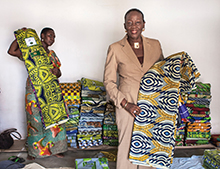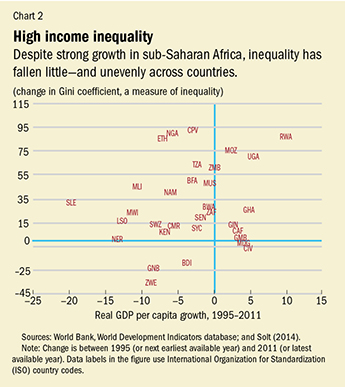In the Driver’s Seat
Finance & Development, June 2016, Vol. 53, No. 2
Christine Dieterich, Dalia Hakura, and Monique Newiak

Gender equality can boost growth in sub-Saharan Africa
Togo’s thriving textile industry is attributed to Maggy Lawson, better known as “Mama Benz” for the striking Mercedes-Benz she—and her mother before her—was famous for driving. In a break from tradition, she inherited her mother’s business and rose to prominence as a businesswoman in the 1970s by selling brightly printed cotton cloth for garments made throughout west Africa. Her immense success created many local jobs.
Mama Benz is just one of many examples of the positive effect women can have on sub-Saharan African economies.
Gender inequality and economic outcomes are intertwined, research shows: stronger growth advances gender equality, and gender equality boosts growth (Duflo, 2012; see Chart 1).

There are many reasons to believe that gender equality lifts growth. Closing worldwide gender gaps in education would give a tremendous boost to global human capital and reduce income inequality (Gonzales and others, 2015b). Women tend to spend more of their household income on the education of their children and grandchildren than men do, so that closing the pay gap between men and women could translate to higher school enrollment for children, in turn leading to higher growth. And more women in the workforce means a larger pool of capable workers and entrepreneurs.
A faster demographic transition—lowering the number of dependent children—can contribute to reducing inequality, particularly for low-income households, and allow greater investment in the human capital of the female labor force (Soares, 2005; Soares and Falcão, 2008).
Sub-Saharan Africa’s labor markets show relatively high female labor force participation, reflecting women’s need to work for subsistence, but the jobs are often in the low-productivity agricultural sector and mostly in the informal sector. Wage employment remains a male-dominated domain—limiting the efficient use of talent.
These inequities are mirrored elsewhere. According to the United Nations (UN) Gender Inequality Index, which measures inequality in the labor market, mortality and fertility rates, education, and empowerment, many countries in sub-Saharan Africa—notably Mali and Niger—stand out as having some of the world’s highest gender inequality.

Income inequality is also high in sub-Saharan Africa. In the past 15 years, rapid growth in the region has boosted per capita income, and poverty rates have fallen. But wide income disparity across the population remains and has even increased in many countries, making incomes in the region the most unequal in the world after Latin America and the Caribbean (see Chart 2). Greater income equality can encourage economic growth because it increases low-income households’ ability to invest in education and physical capital. It can also reduce sociopolitical instability and poor governance, which discourage private investment (Barro, 2000).
Costly inequality
Given that both income and gender inequality are high in the region, and in light of global evidence that such inequity hinders growth, the inevitable question is how much inequality harms economic prosperity in the region.
The potential harm is substantial, though it varies across countries. Our research finds that reducing income and gender inequality to the levels currently observed in the fast-growing economies of southeast Asia (Indonesia, Malaysia, Philippines, Thailand, Vietnam) could boost sub-Saharan Africa’s annual real per capita GDP growth by an average of close to 1 percentage point a year. This is roughly the same order of magnitude as the impact on annual per capita growth of closing the infrastructure gap over the past 10 years between the two regions.
Our study highlights a number of explanations for inequities that are holding back sub-Saharan Africa’s growth potential. Many of these driving forces affect gender inequality and income inequality similarly. Indeed, gender inequality itself propels some income inequality.
Our study also confirms that inequality of opportunity—that is, initial conditions and availability of resources that help people reach their full economic potential—explains much income and gender inequality. For instance, lack of access to education, health care, and basic infrastructure services can limit human capital development and reduce productivity. In sub-Saharan Africa, there has been general improvement, but many countries are still trailing countries with similar incomes in other regions.
Opportunities for women have generally improved—but not enough. For example, male and female primary school enrollment has risen since the turn of the century, driven by the UN Millennium Development Goals. But only 91 girls for every 100 boys are enrolled in primary or secondary school, and only 73 women for every 100 men are at the postsecondary level. The reasons for these gaps range from lack of basic infrastructure, which means more time spent (mainly by females) on household activities to high adolescent fertility rates and early marriage, which bind girls to household work at an early age. In Niger, for example, there are more than 200 births for each 1,000 girls ages 15 to 19, and only 15 percent of girls are enrolled in secondary education.
Similarly, women are behind in access to financial services. The percentage of the population with an account at a financial institution has increased in recent years, but more so for men than for women. In some countries, such as Kenya, mobile-phone-based accounts have overtaken traditional bank accounts and have helped close the gap between income groups in access to finance, but the gender gap in access to mobile money remains high. In Kenya, more than 62 percent of men have a mobile account; fewer than 55 percent of women have such accounts, which limits the benefits of new technology.
And numerous legal restrictions on women’s economic activity remain (World Bank, 2015), which discourages women from saving in a formal institution and borrowing for business activities. These restrictions account for as much as 5 percentage points of the labor market participation gender gap in some countries of the region (Hallward-Driemeier and Hasan, 2013; Demirguc-Kunt, Klapper, and Singer, 2013; Gonzales and others, 2015a). Despite some progress since the 1990s, eight countries in sub-Saharan Africa still have 10 or more such restrictions, including the need for her husband’s consent before a woman can open a bank account or start a new job.
Addressing the problem
A handful of well-designed and targeted policy interventions to open up opportunities for low-income households and women could alleviate inequalities and unleash the region’s growth potential.
Home-based businesses contribute significantly to increasing and diversifying women’s income, especially given their obstacles to wage employment. Currently, fees, levies, and taxes on home businesses are a popular source of revenue for local governments. Opening new sources of local government financing through property tax reform would reduce the burden on household businesses.
Better access to financial services can help address both income and gender inequality. For example, banks will be more likely to lend to new customers if credit bureaus with centralized records make information about potential customers easily available. New technologies such as mobile banking can facilitate access to financial services in remote regions and for women.
Abolishing laws that favor men’s economic activity over women’s is another notable yet easy way to support growth. Some sub-Saharan African countries have taken measures to level the playing field for women. For instance, in 1996 Namibia removed a number of legal barriers facing women, and female labor force participation rose by almost 8 percentage points in the decade that followed. Within the past three years, many sub-Saharan African countries have changed their laws to foster equality. For instance, Guinea’s new labor code now includes a clause on nondiscrimination based on gender; in Kenya the new law on matrimonial property gives both spouses equal rights to administer joint property; and South Africa’s law now mandates equal pay for work of equal value (World Bank, 2015).
Finally, improvements in infrastructure, including better access to electricity and water, will affect growth both directly and by increasing the time girls and women have to participate in education and market activities. That means stronger human capital and an influx of skills to the labor market. Evidence from microsurveys in Ghana suggests that when girls spend half as much time fetching water their school attendance rises by 2.4 percent on average, with larger effects in rural areas (Nauges and Strand, 2013).
Such measures could reduce income and gender inequality in the region substantially and support two goals that are valuable in their own right and that are important drivers for sustained economic growth. In particular, they can help unlock the combined energies of sub-Saharan Africa’s women—paving the way for more success stories like that of Mama Benz. ■
Christine Dieterich and Dalia Hakura are Deputy Division Chiefs and Monique Newiak is an Economist, all in the IMF’s African Department.
This article is based on Chapter 3 of the IMF’s October 2015 Regional Economic Outlook: Sub-Saharan Africa and the forthcoming IMF Working Paper “Inequality, Gender Gaps and Economic Growth: Comparative Evidence for Sub-Saharan Africa,” by Dalia Hakura, Mumtaz Hussain, Monique Newiak, Vimal Thakoor, and Fan Yang.
References
Barro, Robert J., 2000, “Inequality and Growth in a Panel of Countries,” Journal of Economic Growth, Vol. 5, No. 1, pp. 5–32.
Demirguc-Kunt, Asli, Leora Klapper, and Dorothe Singer, 2013,“Financial Inclusion and Legal Discrimination against Women: Evidence from Developing Countries,” World Bank Policy Research Working Paper 6416 (Washington).
Duflo, Esther, 2012, “Women Empowerment and Economic Development,” Journal of Economic Literature, Vol. 50, No. 4, pp. 1051–79.
Gonzales, Christian, Sonali Jain-Chandra, Kalpana Kochhar, and Monique Newiak, 2015a, “Fair Play: More Equal Laws Boost Female Labor Force Participation,” IMF Staff Discussion Note 15/02 (Washington: International Monetary Fund).
——— and Tilek Zeinullayev, 2015b, “Catalyst for Change: Empowering Women and Tackling Income Inequality,” IMF Staff Discussion Note 15/20 (Washington: International Monetary Fund).
Hallward-Driemeier, Mary, and Tazeen Hasan, 2013, Empowering Women: Legal Rights and Economic Opportunities in Africa (Washington: World Bank).
Nauges, Céline, and Jon Strand, 2013, “Water Hauling and Girls’ School Attendance: Some New Evidence from Ghana,” World Bank Policy Research Working Paper 6443 (Washington)
Soares, Rodrigo R., 2005, “Mortality Reductions, Educational Attainment, and Fertility Choice,” American Economic Review, Vol. 95, No. 3, pp. 580–601.
———, and Bruno L.S. Falcão, 2008, “The Demographic Transition and the Sexual Division of Labor,” Journal of Political Economy, Vol. 116, No. 6, pp. 1058–104.
Solt, Frederick, 2014, “The Standardized World Income Inequality Database,” Working Paper. SWIID 5.0, October.
World Bank, 2015, Women, Business and the Law 2016—Getting to Equal (Washington).
Opinions expressed in articles and other materials are those of the authors; they do not necessarily reflect IMF policy.


